Anisotropy of Out-of-Phase Magnetic Susceptibility and Its Potential for Rock Fabric Studies: A Review
Abstract
1. Introduction
2. Theoretical Background
2.1. Physical Principles of Out-Of-Phase Magnetic Susceptibility
2.2. Effect of Mineral Fractions with Exclusive In-Phase Response on the Whole Rock Phase Angle
2.3. Accuracy of opAMS Determination
3. Physical Mechanisms That Produce Out-Of-Phase Susceptibility
- (1)
- viscous relaxation,
- (2)
- electrical eddy currents (induced by AC field in conductive materials),
- (3)
- weak field hysteresis (non-linear and irreversible dependence of M on H).
3.1. Viscous Relaxation
3.2. Electrical Eddy Currents
3.3. Weak Field Hysteresis
4. Examples of Geological Applications
4.1. Instrumentation and Data Processing
4.2. Fabric of Ultrafine Magnetic Particles in Loess/Palaeosol Sequences—Viscous Relaxation
4.3. Preferred Orientation of Graphite in Graphite-Bearing Rocks and Graphite Ores—Eddy Currents
4.4. Preferred Orientation of Pyrrhotite in Eclogite with Complex Magnetic Mineralogy—Weak Field Hysteresis
4.5. Ferromagnetic Mineral Fabric Masked by Paramagnetic Fraction in Whole-Rock AMS in Sedimentary Rocks
5. Discussion
6. Concluding Remarks
Author Contributions
Funding
Data Availability Statement
Acknowledgments
Conflicts of Interest
References
- Hrouda, F.; Chadima, M.; Ježek, J.; Pokorný, J. Anisotropy of out-of-phase magnetic susceptibility of rocks as a tool for direct determination of magnetic sub-fabrics of some minerals: An introductory study. Geophys. J. Int. 2017, 208, 385–402. [Google Scholar] [CrossRef]
- Hrouda, F. Magnetic anisotropy of rocks and its application in geology and geophysics. Geophys. Surv. 1982, 5, 37–82. [Google Scholar] [CrossRef]
- Jackson, M.; Tauxe, L. Anisotropy of magnetic susceptibility and remanence: Developments in the characterization of tectonic, sedimentary and igneous fabric. Rev. Geophys. Suppl. 1991, 29, 371–376. [Google Scholar] [CrossRef]
- Tarling, D.H.; Hrouda, F. The Magnetic Anisotropy of Rocks; Chapman & Hall: London, UK, 1993; p. 217. [Google Scholar]
- Borradaile, G.J.; Jackson, M. Structural geology, petrofabrics and magnetic fabrics (AMS, AARM, AIRM). J. Struct. Geol. 2010, 32, 1519–1551. [Google Scholar] [CrossRef]
- Henry, B.; Daly, L. From qualitative to quantitative magnetic anisotropy analysis: The prospect of finite strain calibration. Tectonophysics 1983, 98, 327–336. [Google Scholar] [CrossRef]
- Henry, B. Interpretation quantitative de l’anisotropie de susceptibilité magnétique. Tectonophysics 1983, 91, 165–177. [Google Scholar] [CrossRef]
- Hrouda, F. The use of the anisotropy of magnetic remanence in the resolution of the anisotropy of magnetic susceptibility into its ferromagnetic and paramagnetic components. Tectonophysics 2002, 347, 269–281. [Google Scholar] [CrossRef]
- Hrouda, F.; Pokorný, J.; Ježek, J.; Chadima, M. Out-of-phase magnetic susceptibility of rocks and soils: A rapid tool for magnetic granulometry. Geophys. J. Int. 2013, 194, 170–181. [Google Scholar] [CrossRef]
- Hrouda, F.; Pokorný, J. Extremely high demands for measurement accuracy in precise determination of frequency-dependent magnetic susceptibility of rocks and soils. Stud. Geophys. Geod. 2011, 55, 667–681. [Google Scholar] [CrossRef]
- Hrouda, F.; Pokorný, J. Modelling accuracy limits for frequency-dependent anisotropy of magnetic susceptibility of rocks and soils. Stud. Geophys. Geod. 2012, 56, 789–802. [Google Scholar] [CrossRef]
- Jelínek, V. The Statistical Theory of Measuring Anisotropy of Magnetic Susceptibility of Rocks and Its Application; Geofyzika n.p.: Brno, Czech Republic, 1977. [Google Scholar]
- Jackson, M. Imaginary susceptibility, a primer. IRM Q. 2003, 13, 10–11. [Google Scholar]
- Neél, L. Théorie du trainage magnétique des ferrimagnétiques en grains fins avec applications aus terres cuites. Ann. Géophys. 1949, 5, 99–136. [Google Scholar]
- Egli, R. Magnetic susceptibility measurements as a function of temperature and frequency I: Inversion theory. Geophys. J. Int. 2009, 177, 395–420. [Google Scholar] [CrossRef]
- Worm, H.-U. On the superparamagnetic—Stable single domain transition for magnetite, and frequency dependence of susceptibility. Geophys. J. Int. 1998, 133, 201–206. [Google Scholar] [CrossRef]
- Hrouda, F. Models of frequency-dependent susceptibility of rocks and soils revisited and broadened. Geophys. J. Int. 2011, 187, 1259–1269. [Google Scholar] [CrossRef]
- Hrouda, F.; Hanák, J.; Terzijski, I. The magnetic and pore fabrics of extruded and pressed ceramic models. Geophys. J. Int. 2000, 142, 941–947. [Google Scholar] [CrossRef][Green Version]
- Hrouda, F.; Chadima, M.; Ježek, J.; Kadlec, J. Anisotropies of in-phase, out-of- phase, and frequency-dependent susceptibilities in three loess/palaeosol profiles in the Czech Republic; methodological implications. Stud. Geophys. Geod. 2018, 62, 272–290. [Google Scholar] [CrossRef]
- Wait, J.R. A conducting sphere in a time varying magnetic field. Geophysics 1951, 16, 666–672. [Google Scholar] [CrossRef]
- Landau, L.D.; Lifshitz, E.M. Electrodynamics of Continuous Media. In Course of Theoretical Physics; Pergamon Press: Oxford, UK, 1960; Volume 8. [Google Scholar]
- Chambers, R.G.; Park, J.G. Measurement of electrical resistivity by a mutual inductance method. Br. J. Appl. Phys. 1961, 12, 507–510. [Google Scholar] [CrossRef]
- Chen, D.-X.; Gu, C. AC susceptibilities of conducting cylinders and their application in Electromagnetic measurements. IEEE Trans. Magn. 2005, 41, 2436–2446. [Google Scholar] [CrossRef]
- Zhilichev, Y. Solutions of eddy-current problems in a finite length cylinder by separation of variables. Prog. Electromagn. Res. B 2018, 81, 81–100. [Google Scholar] [CrossRef][Green Version]
- Ježek, J.; Hrouda, F. Startingly strong shape anisotropy of AC magnetic susceptibility due to eddy currents. Geophys. J. Int. 2022, 229, 359–369. [Google Scholar] [CrossRef]
- Hrouda, F.; Franěk, J.; Gilder, S.; Chadima, M.; Ježek, J.; Mrázová, Š.; Poňavič, M.; Racek, M. Lattice preferred orientation of graphite determined by the anisotropy of out-of-phase magnetic susceptibility. J. Struct. Geol. 2022, 154, 104491. [Google Scholar] [CrossRef]
- Neél, L. Theory of Rayleigh’s law of magnetization. Cahier Phys. 1942, 12, 1–20. [Google Scholar]
- Newell, A.J. Frequency dependence of susceptibility in magnets with uniaxial and triaxial anisotropy. J. Geophys. Res. Solid Earth 2017, 122, 7544–7561. [Google Scholar] [CrossRef]
- Hrouda, F.; Gilder, S.; Wack, M.; Ježek, J. Diverse response of paramagnetic and ferromagnetic minerals to deformation from Intra-Carpathian Palaeogene sedimentary rocks: Comparison of magnetic susceptibility and magnetic remanence anisotropies. Jour. Struct. Geol. 2018, 113, 217–224. [Google Scholar] [CrossRef]
- Hrouda, F.; Ježek, J.; Chadima, M. On the origin of apparently negative minimum susceptibility of hematite single crystals calculated from low-field anisotropy of magnetic susceptibility. Geophys. J. Int. 2021, 224, 1905–1917. [Google Scholar] [CrossRef]
- Studýnka, J.; Chadima, M.; Suza, P. Fully automated measurement of anisotropy of magnetic susceptibility using 3D rotator. Tectonophysics 2014, 629, 6–13. [Google Scholar] [CrossRef]
- Pokorný, P.; Pokorný, J.; Chadima, M.; Hrouda, F.; Studýnka, J.; Vejlupek, J. KLY5 Kappabridge: High sensitivity and anisotropy meter precisely decomposing in-phase and out-of-phase components. In EGU2016-15806 Abstract 2016; SAO/NASA Astrophysics Data System: Washington, DC, USA, 2016. [Google Scholar]
- Pokorný, J.; Pokorný, P.; Suza, P.; Hrouda, F. A multi-function Kappabridge for high precision measurement of the AMS and the variations of magnetic susceptibility with field, temperature and frequency. In The Earth’s Magnetic Interior, IAGA Special Sopron Book Series; Petrovský, E., Herrero-Bervera, E., Harinarayana, T., Ivers, D., Eds.; Springer: Dordrecht, The Netherlands, 2011; Volume 1, pp. 292–301. [Google Scholar]
- Parma, J.; Hrouda, F.; Pokorný, J.; Wohlgemuth, J.; Suza, P.; Šilinger, P.; Zapletal, K. A technique for measuring temperature dependent susceptibility of weakly magnetic rocks. Spring meeting 1993 EOS. Trans. Am. Geophys. Union 1993, 113. [Google Scholar]
- Petrovský, E.; Kapička, A. On determination of the curie point from thermomagnetic curves. J. Geophys. Res. 2006, 111, B12S27. [Google Scholar] [CrossRef]
- Nagata, T. Rock Magnetism; Maruzen: Tokyo, Japan, 1961. [Google Scholar]
- Jelínek, V. Characterization of magnetic fabric of rocks. Tectonophysics 1981, 79, T63–T67. [Google Scholar] [CrossRef]
- Jelínek, V. Statistical processing of magnetic susceptibility measured on groups of specimens. Studia Geophys. Geod. 1978, 22, 50–62. [Google Scholar] [CrossRef]
- Chadima, M.; Jelínek, V. Anisoft 4.2—Anisotropy data browser. Contrib. Geophys. Geod. 2008, 38, 41. [Google Scholar]
- Dearing, J.A.; Dann, R.J.L.; Hay, K.; Lees, J.A.; Loveland, P.J.; Maher, B.A.; O’Grady, K. Frequency-dependent susceptibility measurements of environmental materials. Geophys. J. Int. 1996, 124, 228–240. [Google Scholar] [CrossRef]
- Bradák, B. Application of anisotropy of magnetic susceptibility (AMS) for the determination of paleo-wind directions and paleo-environment during the accumulation period of Bag Tephra, Hungary. Quart. Int. 2009, 189, 77–84. [Google Scholar] [CrossRef]
- Makarova, T.L. Magnetic properties of carbon structures. Semiconductors 2004, 38, 615–638. [Google Scholar] [CrossRef]
- Dutta, A.K. Electrical conductivity of single crystals of graphite. Phys. Rev. 1953, 90, 187–192. [Google Scholar] [CrossRef]
- Hrouda, F. A technique for the measurement of thermal changes of magnetic susceptibility of weakly magnetic rocks by the CS-2 apparatus and KLY-2 Kappabridge. Geophys. J. Int. 1994, 118, 604–612. [Google Scholar] [CrossRef]
- Hrouda, F.; Potfaj, M. Deformation of sediments in the post-orogenic Intra-Carpathian Paleogene Basin as indicated by magnetic anisotropy. Tectonophysics 1993, 224, 425–434. [Google Scholar] [CrossRef]
- Pešková, I.; Vojtko, R.; Starek, D.; Sliva, L. Late eocene to quaternary deformation and stress field evolution of the Orava region (Western Carpathians). Acta Geol. Pol. 2009, 59, 73–91. [Google Scholar]
- Nemčok, M. Transition from convergence to escape: Field evidence from the Western Carpathians. Tectonophysics 1993, 217, 117–142. [Google Scholar]
- Osborn, J.A. Demagnetizing factors of the general ellipsoid. Phys. Rev. 1945, 67, 351–357. [Google Scholar] [CrossRef]
- Stoner, E.C. The demagnetizing factors for ellipsoid. Philos. Mag. 1945, 36, 803–820. [Google Scholar] [CrossRef]
- Uyeda, S.; Fuller, M.D.; Belshe, J.C.; Girdler, R.W. Anisotropy of magnetic susceptibility of rocks and minerals. J. Geophys. Res. 1963, 68, 279–292. [Google Scholar] [CrossRef]
- Jelinek, V. Theory and measurement of the anisotropy of isothermal remanent magnetization of rocks. Trav. Geophys. 1993, 37, 124–134. [Google Scholar]
- Stacey, F.D.; Benerjee, S.K. The Physical Principles of Rock Magnetism; Elsevier: Amsterdam, The Netherlands, 1974; p. 195. [Google Scholar]
- Biedermann, A.R. Magnetic anisotropy in single crystals: A review. Geosciences 2018, 8, 302. [Google Scholar] [CrossRef]
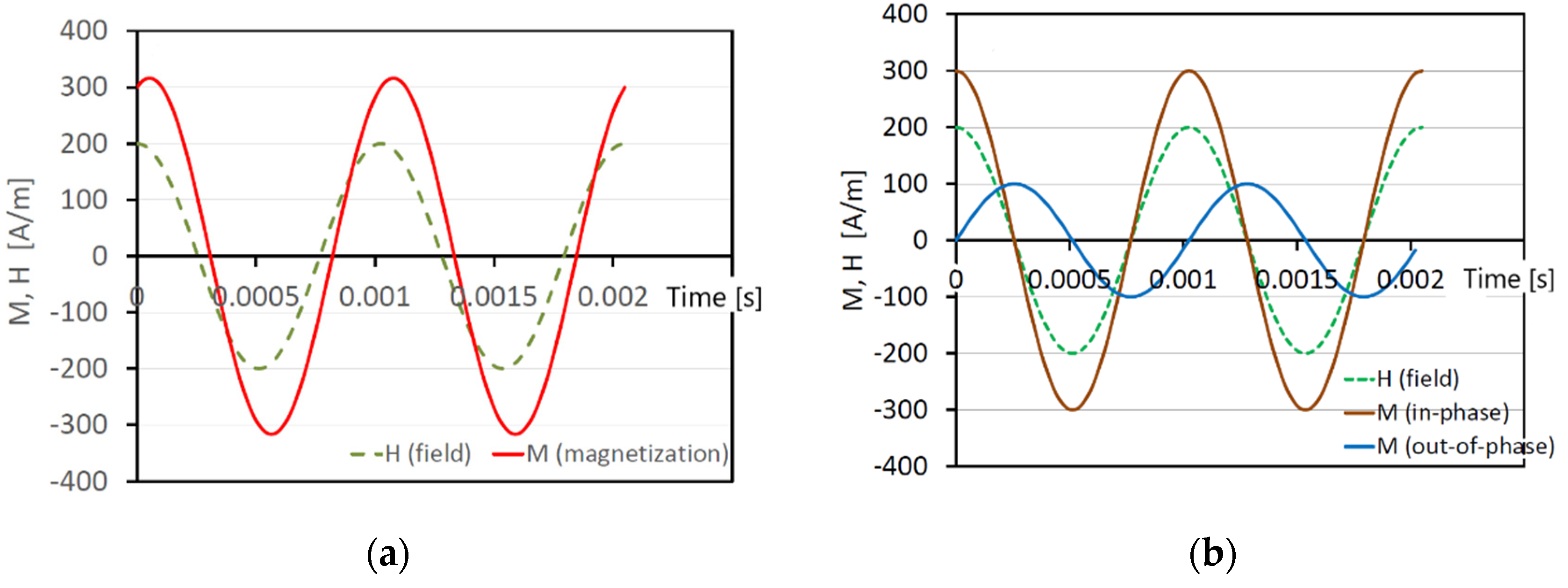


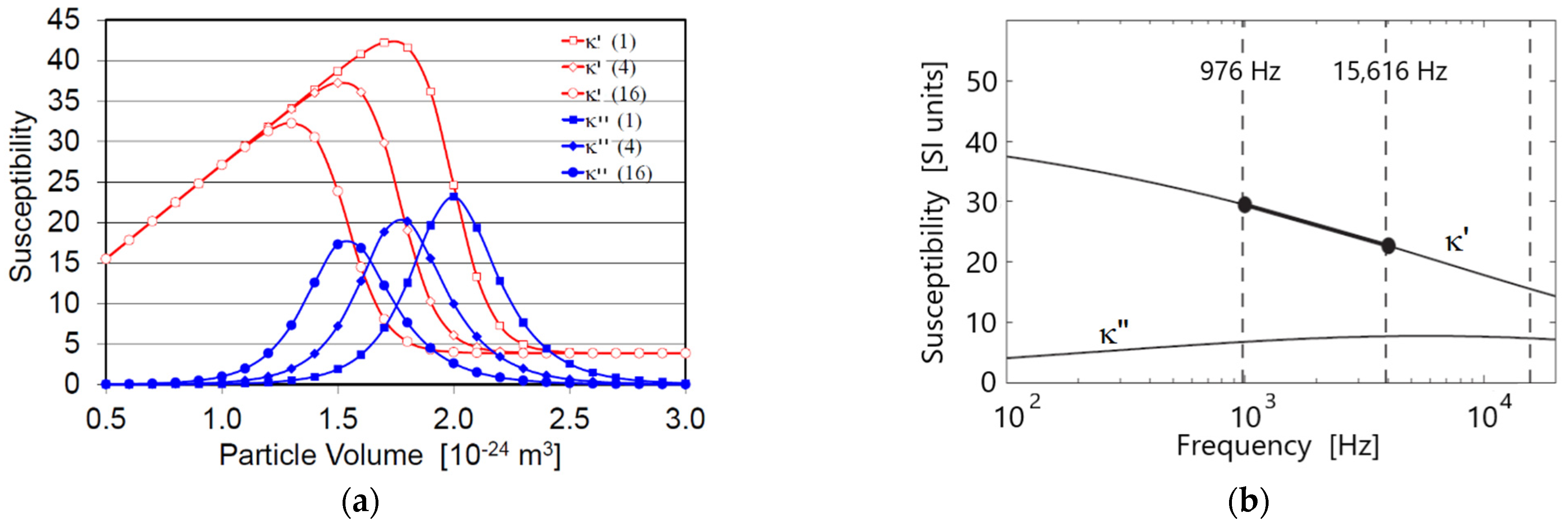

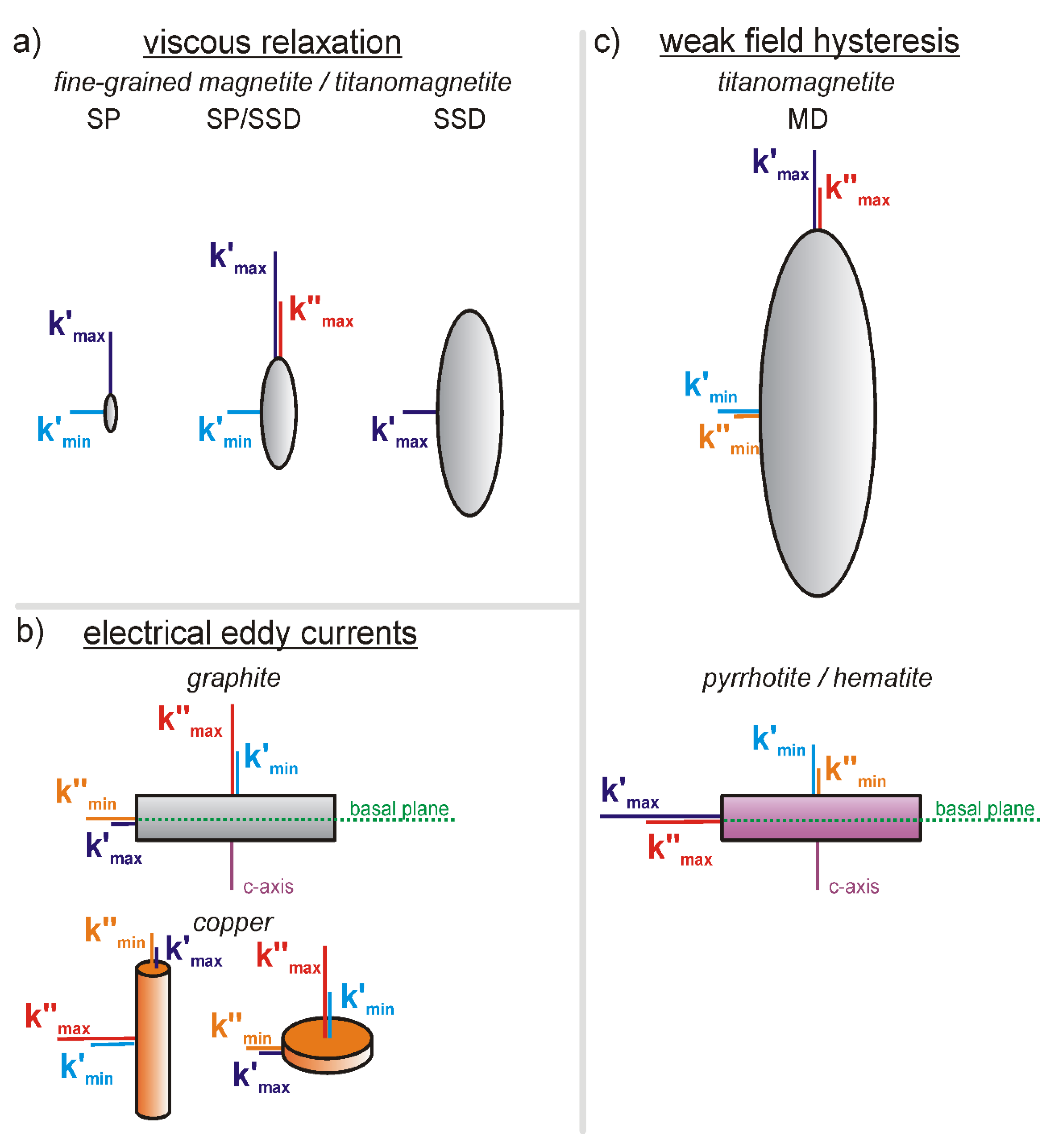
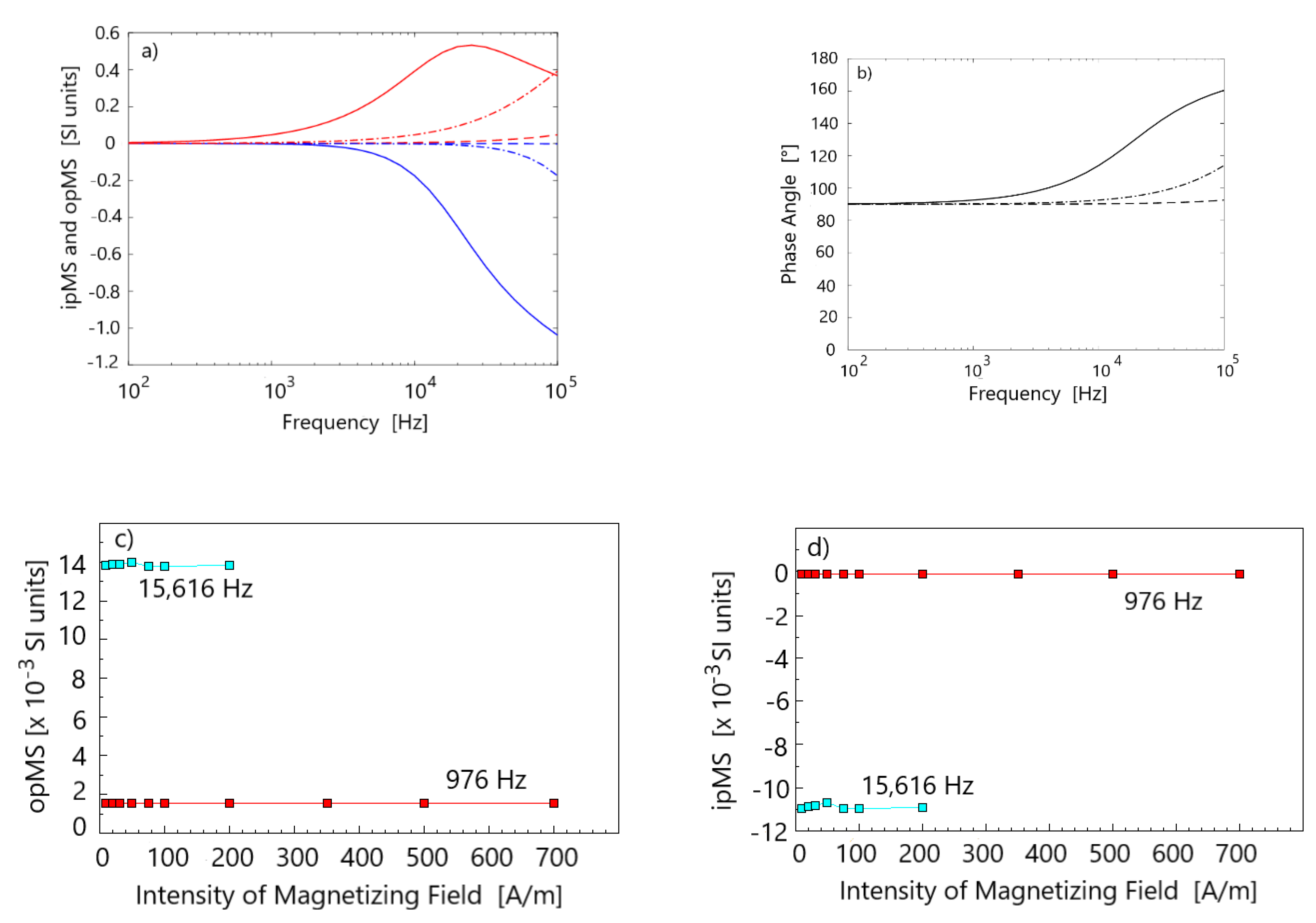
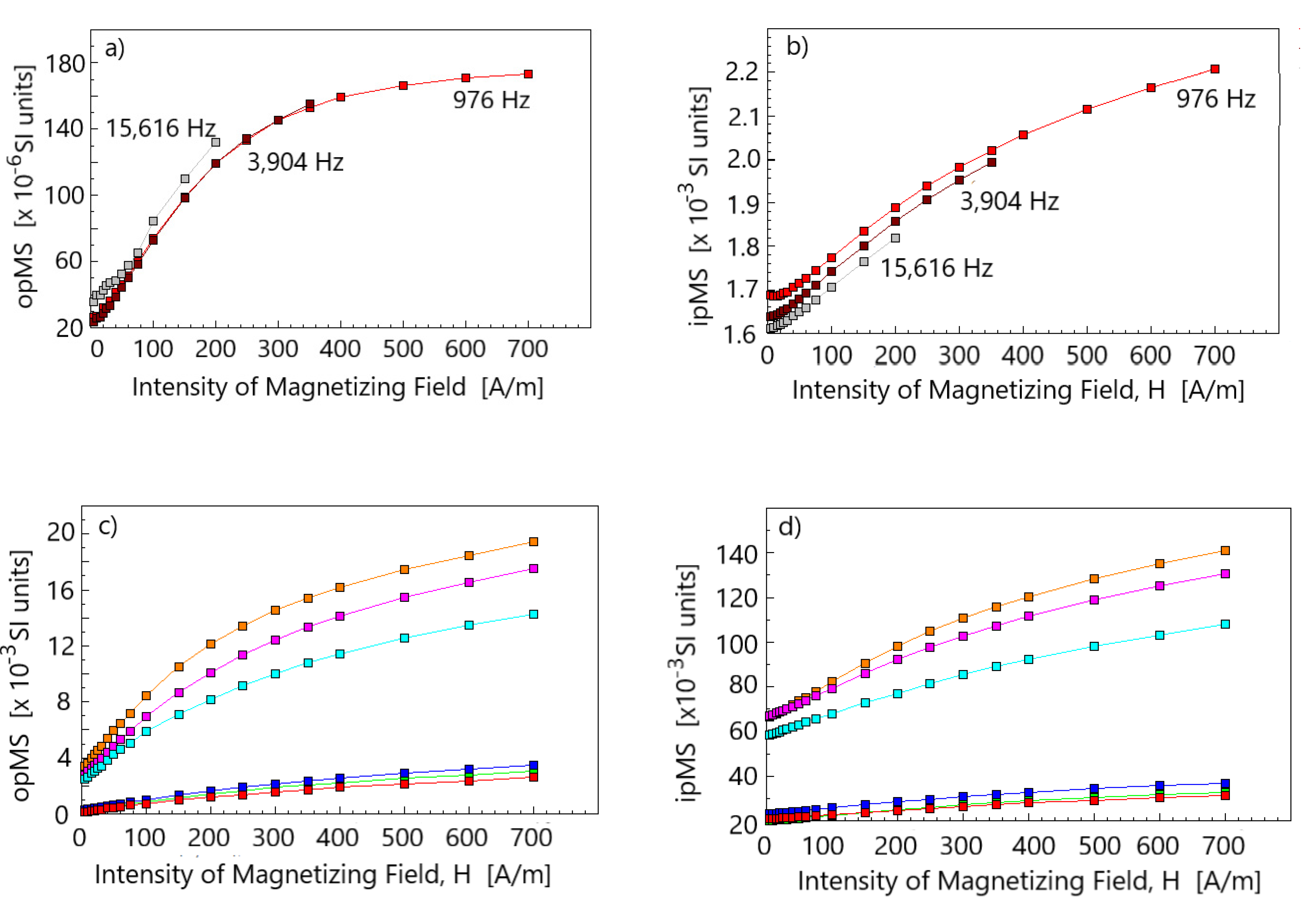

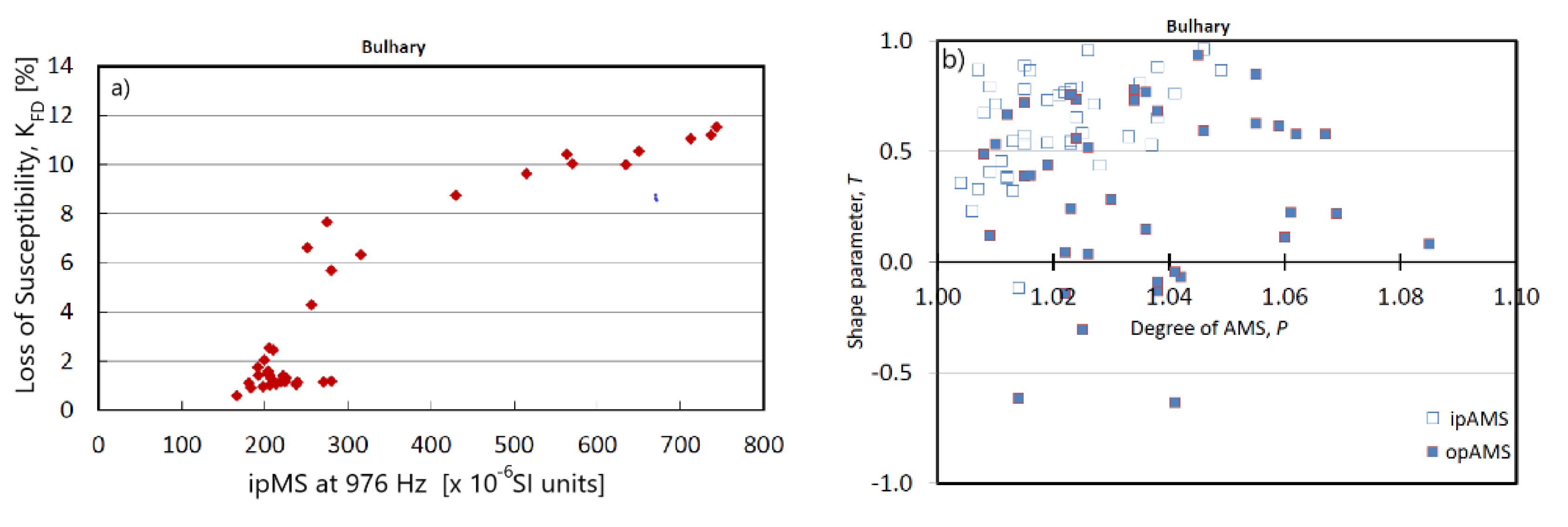
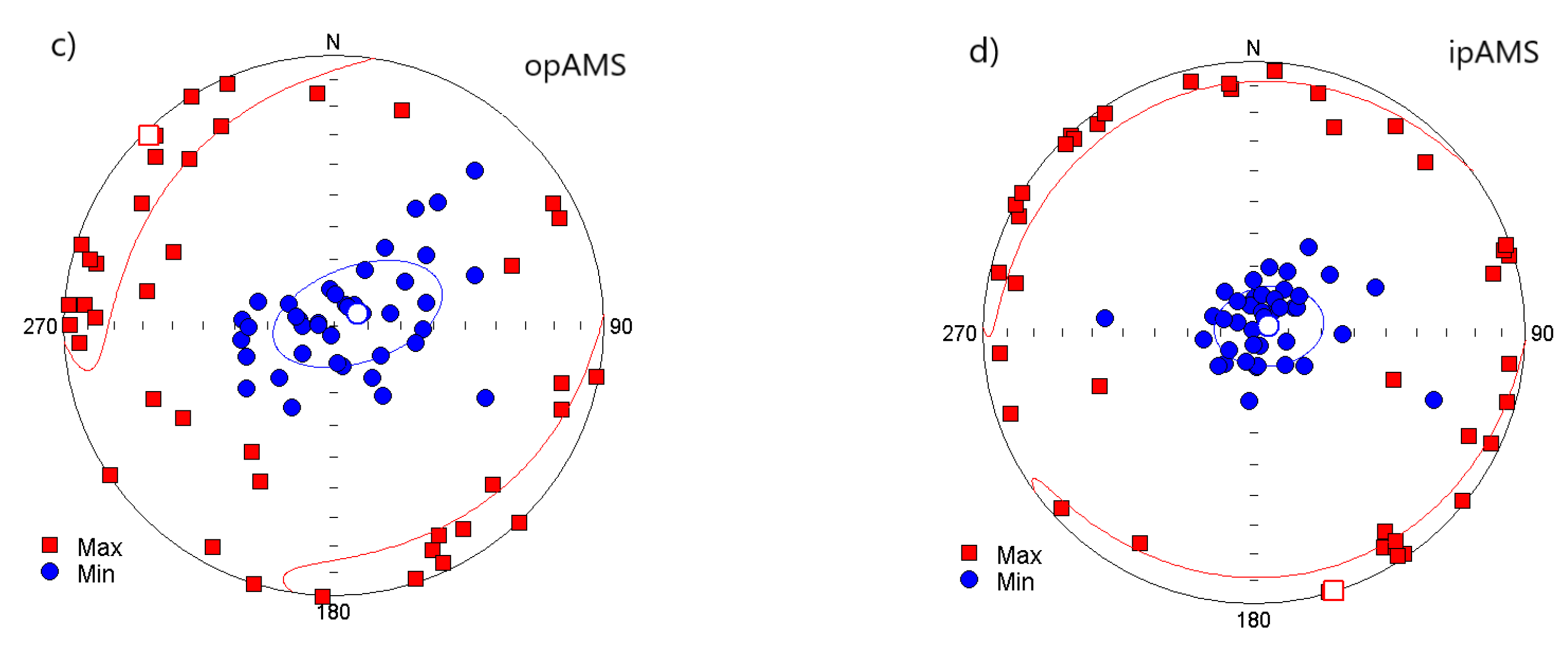
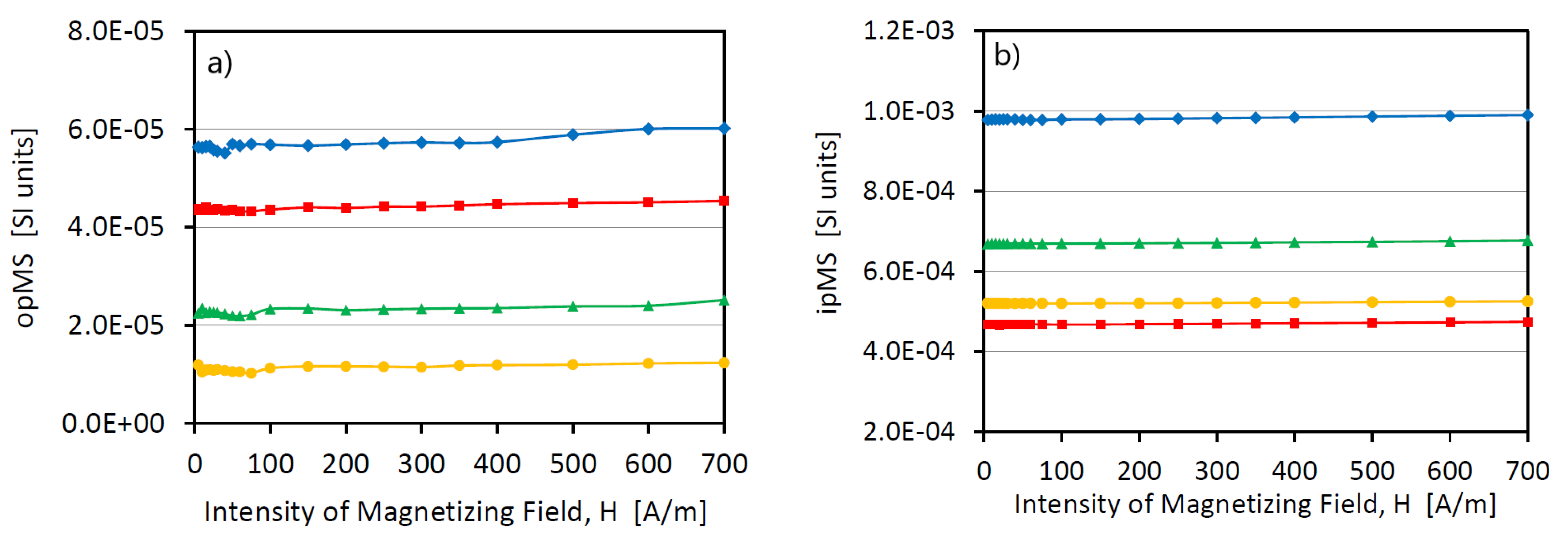
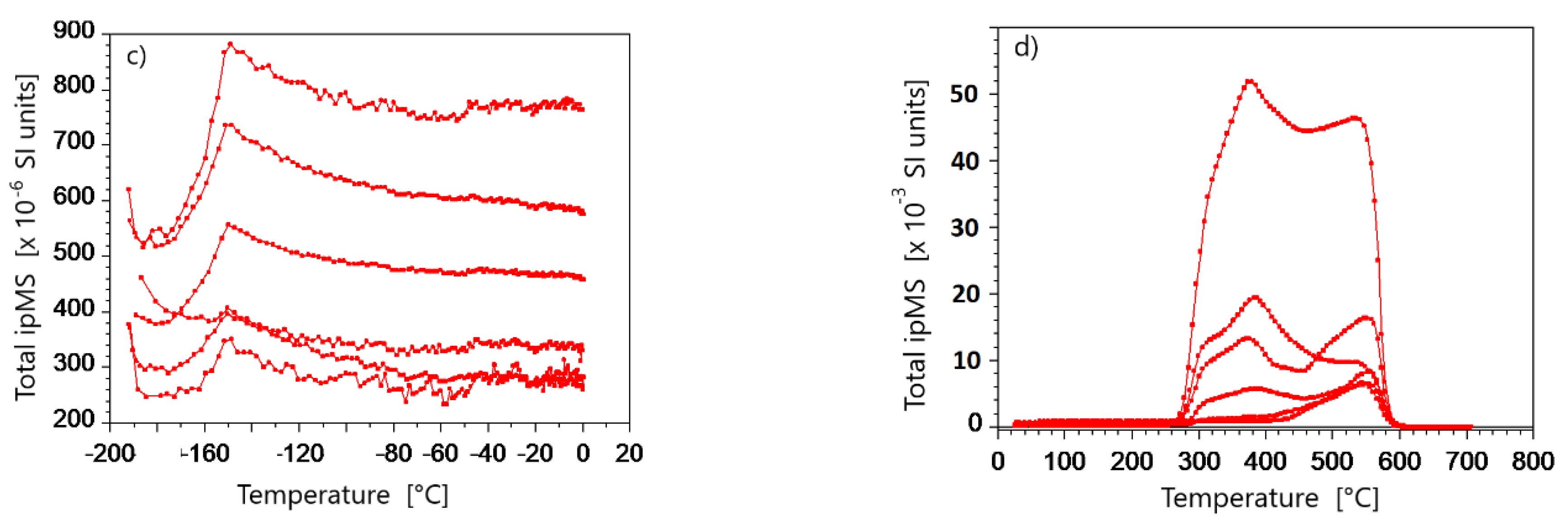

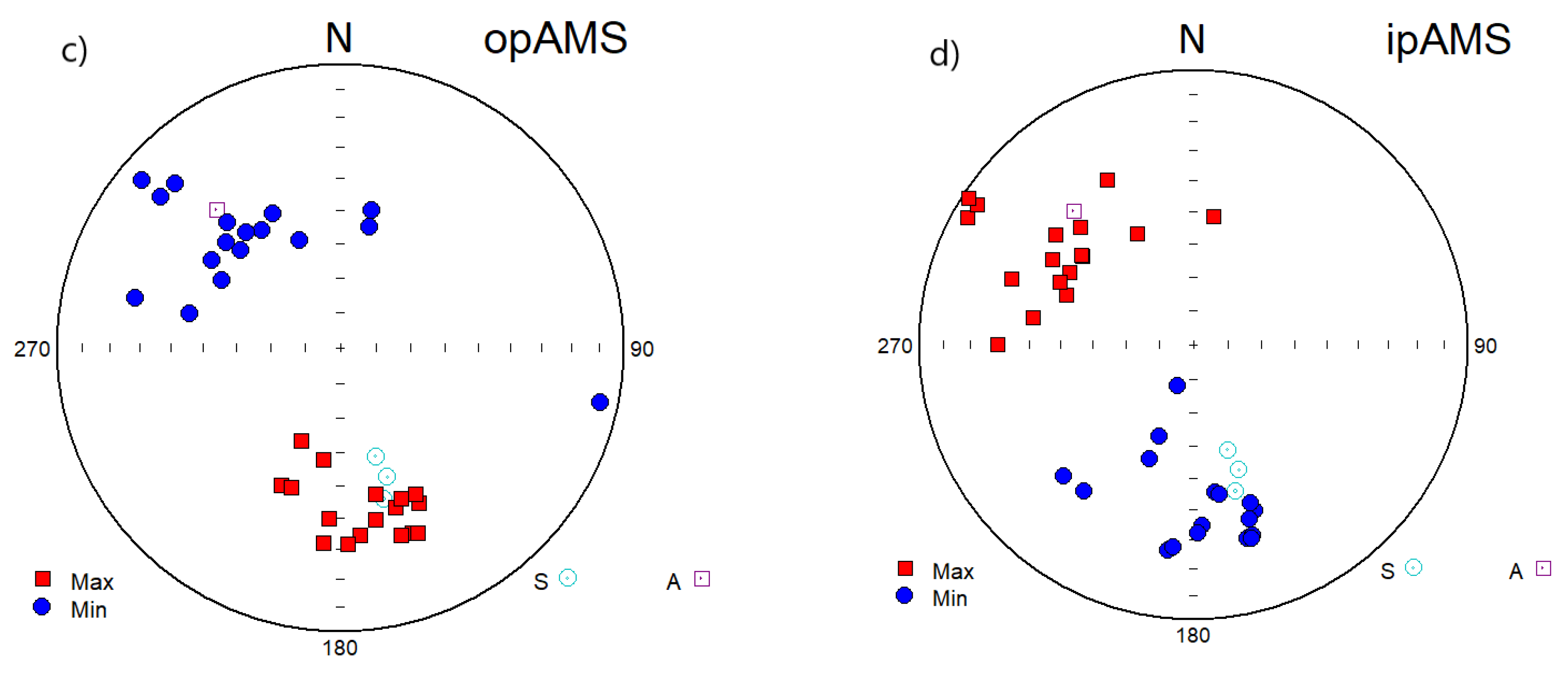
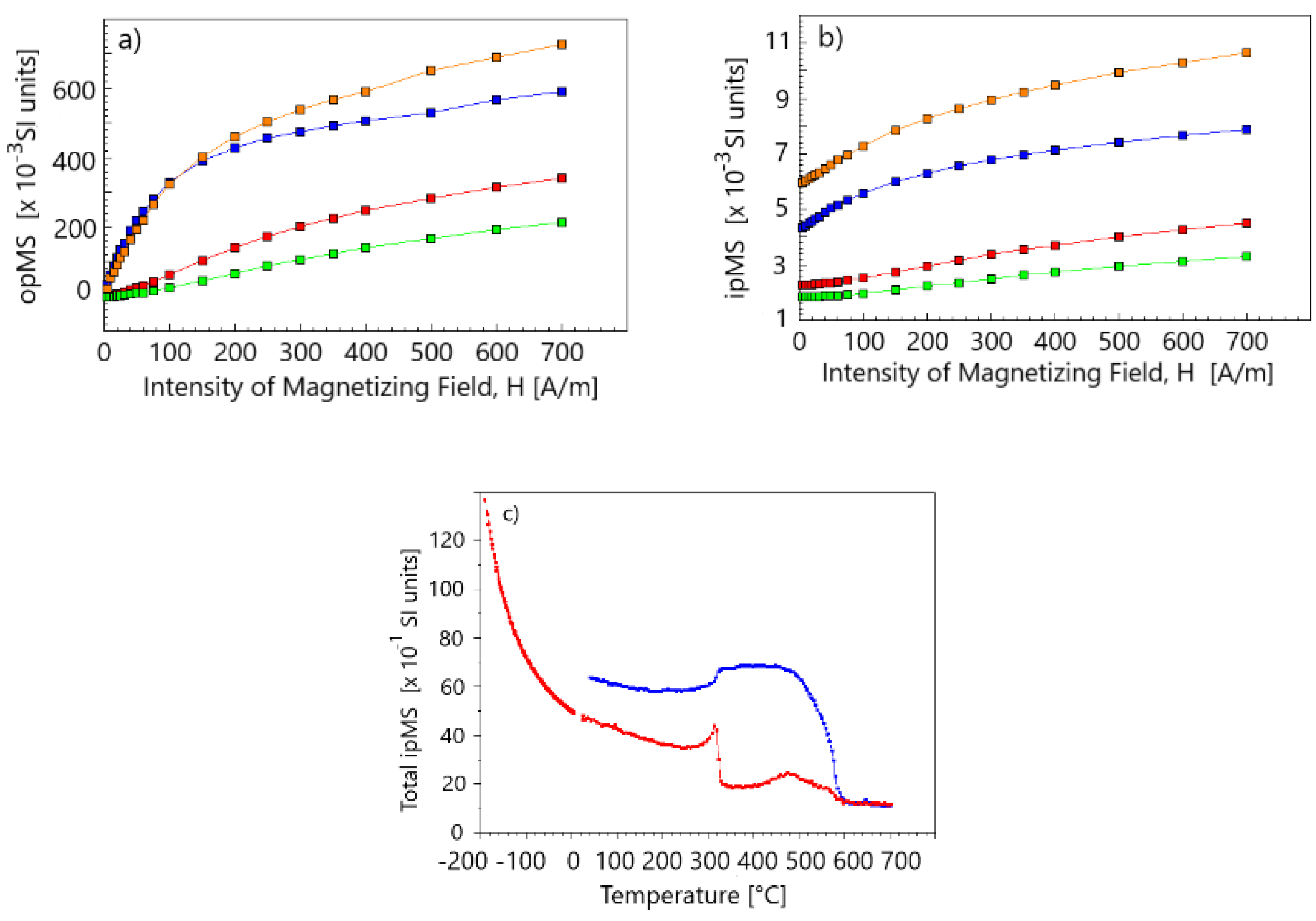
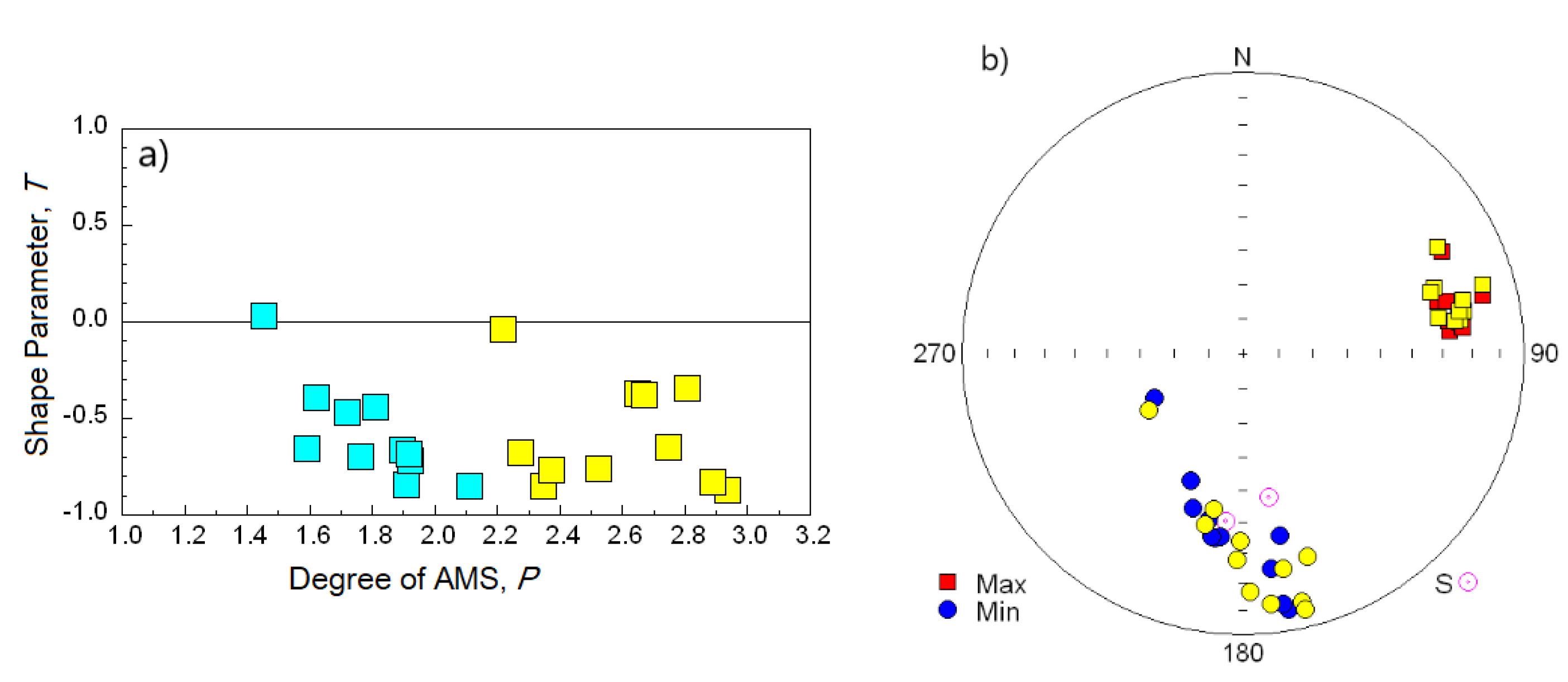

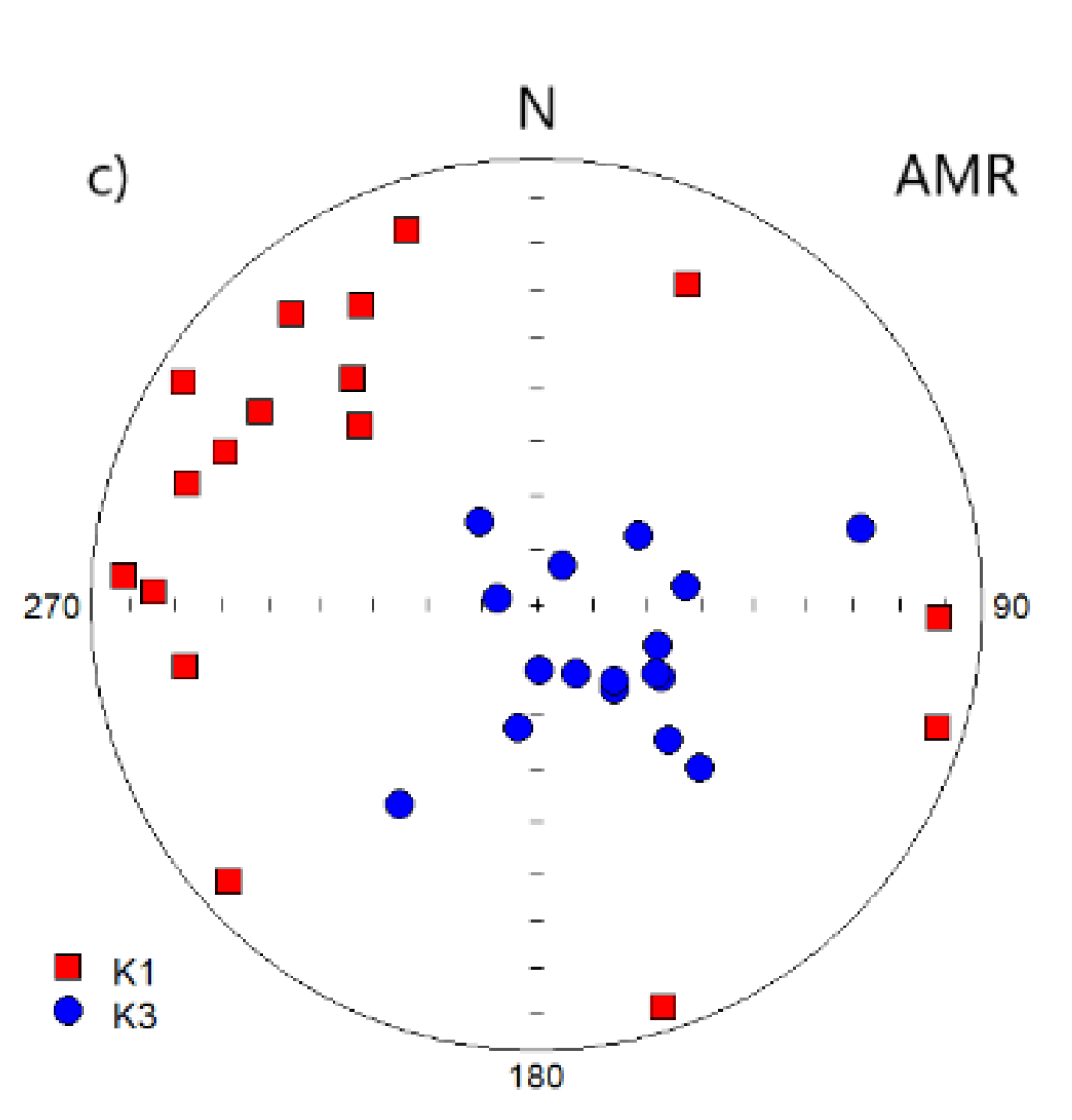
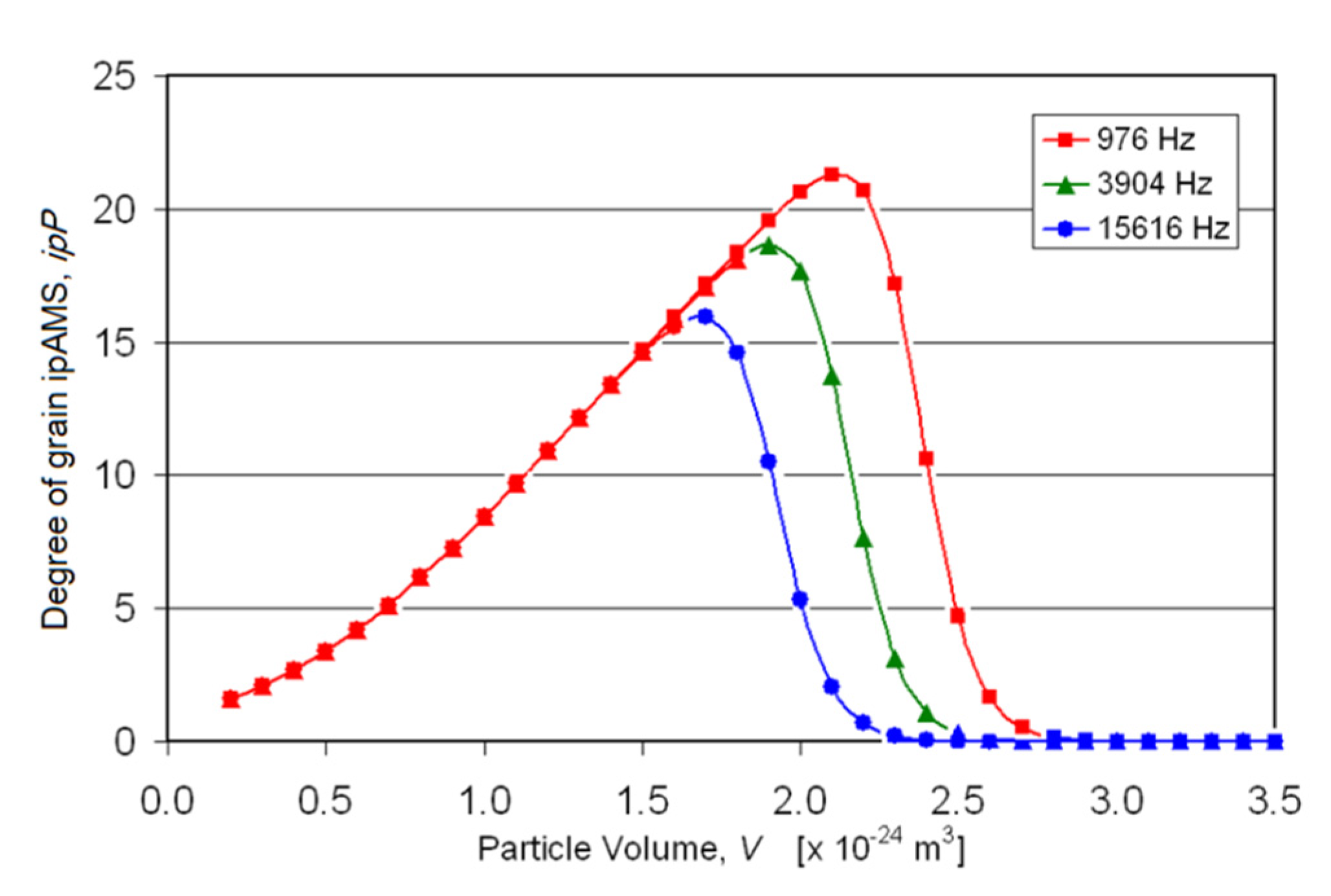
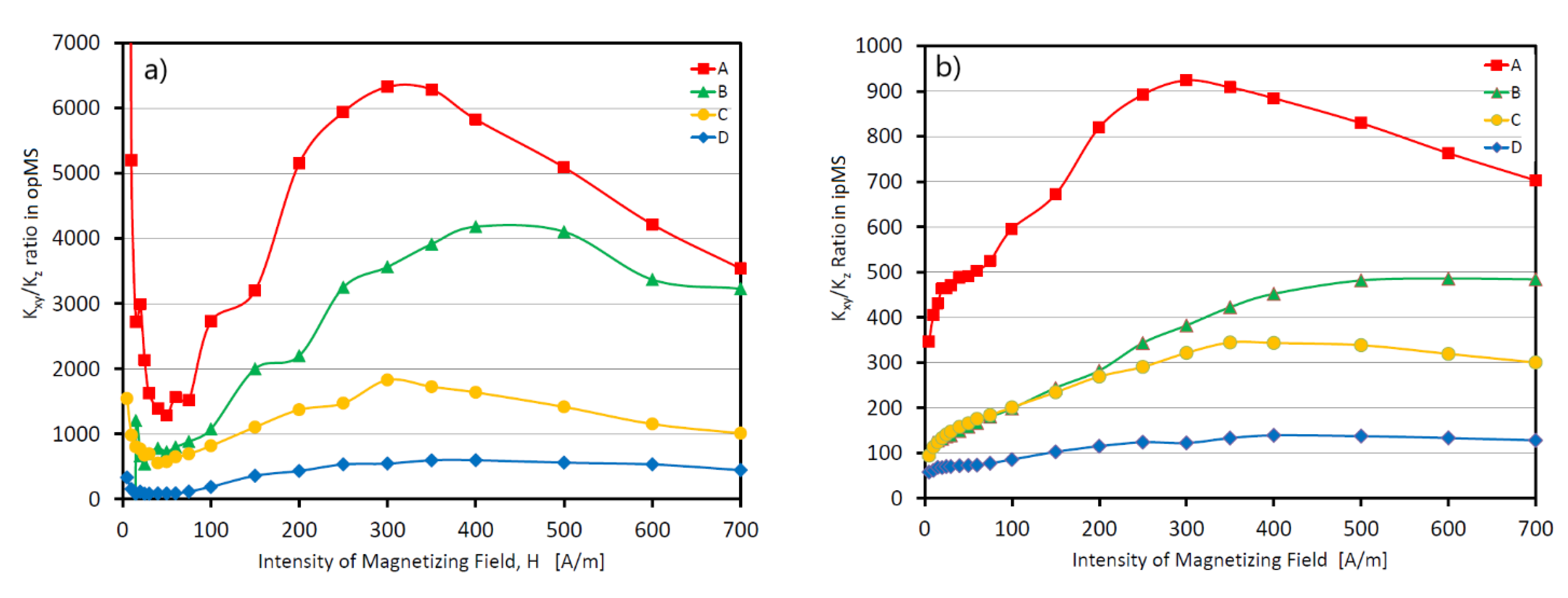
Publisher’s Note: MDPI stays neutral with regard to jurisdictional claims in published maps and institutional affiliations. |
© 2022 by the authors. Licensee MDPI, Basel, Switzerland. This article is an open access article distributed under the terms and conditions of the Creative Commons Attribution (CC BY) license (https://creativecommons.org/licenses/by/4.0/).
Share and Cite
Hrouda, F.; Chadima, M.; Ježek, J. Anisotropy of Out-of-Phase Magnetic Susceptibility and Its Potential for Rock Fabric Studies: A Review. Geosciences 2022, 12, 234. https://doi.org/10.3390/geosciences12060234
Hrouda F, Chadima M, Ježek J. Anisotropy of Out-of-Phase Magnetic Susceptibility and Its Potential for Rock Fabric Studies: A Review. Geosciences. 2022; 12(6):234. https://doi.org/10.3390/geosciences12060234
Chicago/Turabian StyleHrouda, František, Martin Chadima, and Josef Ježek. 2022. "Anisotropy of Out-of-Phase Magnetic Susceptibility and Its Potential for Rock Fabric Studies: A Review" Geosciences 12, no. 6: 234. https://doi.org/10.3390/geosciences12060234
APA StyleHrouda, F., Chadima, M., & Ježek, J. (2022). Anisotropy of Out-of-Phase Magnetic Susceptibility and Its Potential for Rock Fabric Studies: A Review. Geosciences, 12(6), 234. https://doi.org/10.3390/geosciences12060234




